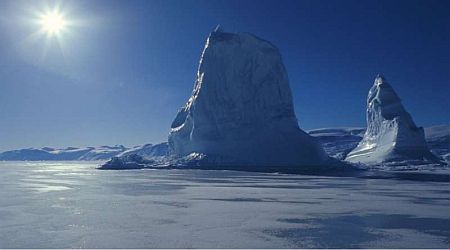
Thanks to global warming, Greenland may not stay an oxymoron for too long. Curiously named, this island nation, except the southern part in summer, is covered in snow. However, NASA believes that this might not be the case for too long.
As per the satellite observations of NASA, last year Greenland experienced a greater number of melting snow days than the average established over the past 18 years. Not only that, the snow melted at higher altitudes than ever before. Daily observations by satellite sensors since 1998 show that island’s melting days have increased progressively.
Marco Tedesco – a scientist at the Joint Center for Earth Systems Technology and NASA’s Goddard Space Flight center in Maryland – who was the lead scientist of the study, said:
We now have the ability to monitor melting snow on Greenland’s ice sheet on a daily basis using sensors on satellites measuring the electromagnetic signal naturally emitted by the ice sheet. The sensors detected that snowmelt occurred more than 10 days longer than the average over certain areas of Greenland in 2006.

The ‘certain areas’ that he referred to are primarily located along Greenland’s western, southwestern and northeastern coast.
The findings of the study are published in the May 29 issue of the American Geophysical Union’s Eos. Tedesco’s ‘melt index,’ which assesses the impact of global warming on Greenland’s snow by multiplying the number of melting days by the melting area, arrived at the damning conclusions.
An increase at the rate at which the snow is melting would mean a consequent increase in sea level around the world. If somehow, and God forbid, Greenland’s entire glacial sheet was to melt, ocean levels around the world would rise by as much as 20 feet. This would mean a certain deluge for a large number of coastal areas and would cause mass human migration.
In addition to this frightening scenario, there is the effect of melting snow on already floating glacial sheets. Add to this the adverse effect that an increased rate of melting would have on earth-sun radiation equation and the scenario becomes bleaker. Of course, there would be a loss in the amount of sun’s radiation reflected back to the atmosphere. This would make already hot areas hotter.
Tedesco remarked:
Although wet and dry snow look similar at first glance, wet and re-frozen snow absorb more of the sun’s radiation, reflecting only 50-60 percent back into the atmosphere. Dry snow, on the other hand, reflects about 85 percent of the sun’s radiation.
Melting snow would have a positive effect, in that it would make the uninhabitable polar areas conducive to human settlement. This positive will be more than offset by the negatives that increased sea levels would unleash around the world.
Image
Source

